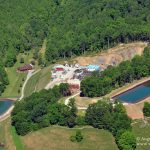The publication below was first written in 2010. The Marcellus Shale boom was just getting started then. When it was written, surface owners had to fight tooth and nail to get paid “$1 per inch per foot” (one dollar per inch of diameter of the proposed pipeline times length in feet the pipeline would cross the tract). We knew the pipelines were worth that much, but landmen often weren’t given that size of a budget so it was hard.
By 2013 we found out that Marcellus Shale pipelines are worth way MORE than that. If you are only being offered $1 per inch per foot, you are getting underpaid. Professionals representing surface owners believe you should get $35 to $45 per foot. (Of course the ultimate amount you can get is determined by what it would cost them to go around you — so make sure your neighbors know about this amount too!) If you own thousands of acres you can get more than that, and you should not be getting advice from us — you should be contacting a lawyer or a land-management professional.
The latest version of this pamphlet was written in August, 2014. If you know someone who has the old one you should tell them there is a new one. In addition to the changed advice on price, there are a few small changes so the basic advice in the old pamphlet is sound.
Please let us know how much you get when you get better than $1 per inch per foot, so we can help the next guy! Here is how to contact us.
What Land/Surface Owners Should Know When a Landman Shows Up And Wants an Easement/Right of Way To Put a Pipeline Across Your Land
(updated 8/27/2014)
One big environmental problem with pipelines is that they can serve as conduits for invasive species to spread. So proper seeding practices are important. The West Virginia Department of Natural Resource’s has no regulatory authority over pipelines, but it has published a manual for how to reseed and otherwise reclaim land where pipelines (and other oil and gas land disturbance) has occurred. The DNR’s manual is referenced in the Soil Erosion and Sediment Control Field Manual that the Department of Environmental Protection has and does enforce oil and gas well sites. We recommend that if you are negotiating for a pipeline right of way that you read the Department of Natural Resources’ manual and insist in the written right of way agreement that the recommended seeding of the DNR’s manual below be used. This should not be hard to get the pipeline company to agree to, so don’t give up anything to get it.
Enhancing Wildlife Habitat on Oil and Gas Infrastructure



